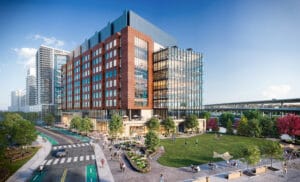
WiredScore ratings are used to assess the digital infrastructure of commercial buildings owned by landlords including DivcoWest, developer of Cambridge Crossing which will include the headquarters of Phillips North America and the local operations for French drug-maker Sanofi Genzyme. Image courtesy of Tsoi Kobus Design
The next time you’re in an office building, take a look around. Can you tell if you’re standing in a “smart” or “intelligent” building? What can you learn from the faces of the employees busily crisscrossing the lobby and corridors? It’s not always easy to decipher these conclusions on the surface.
The reliability of the internet, efficiency of in-building tech and overall connectivity can make employees’ lives easier, more productive and ultimately help with employee retention. Tenants are no longer just looking for a series of rooms to run their business in. They expect their office space to actually improve their productivity. In 2020, smart buildings and enhanced in-building technology can be an invaluable aid to supporting tenants and increasing their happiness at work which, in turn, makes an owner’s space more valuable to the marketplace, at large.
Smart Versus Intelligent Buildings
Imagine each component of your building’s services as its own library of information.
What is your office’s suite of services (HVAC, electric, etc.) doing with its data? Is it sitting dormant in the hard drive of a building manager? Is it being analyzed and used to optimize efficiency or minimize energy costs? Is it being collected at all?
Here is where the distinction between smart and intelligent buildings comes into play. Whereas a smart building merely collects data from systems such as HVAC, lighting and security, an intelligent building collects this data, analyzes it and uses the findings to optimize performance and enhance the tenant experience.
Imagine a busy metropolitan office building. Every day, thousands of people pass through electric turnstiles in this building that are opened by a keycard or fob.
Previously, a central data hub likely tracked activity within the turnstiles, only coming into action when an irregularity took place. For example, if somebody passed through the turnstile without a keycard it would buzz to alert a security guard. A smart building would collect this data, but never examine it. The computer system was used to detect issues, not for optimization or prediction.
However, an intelligent building would possess an analytics platform to examine the data and use it to make the building work more efficiently. In this example, the building’s analytics system “sees” a strong pattern of turnstile traffic around noon. So automatically, the building decreases the HVAC system’s output to save energy while fewer people are in the building.
The key, here, is data-driven automation which can extend to lighting, elevators, security and more. This saves property managers the headaches of constantly tinkering with different controls. It shows asset managers that the buildings are running on a more cost-efficient scale. And ultimately, it makes the building more profitable to ownership and investors.
But a key piece is missing here and must be taken into account for intelligent buildings to succeed: the happiness of the building’s tenants.
The Benefits to Tenants
Landlords have the power to leverage both superior digital connectivity and intelligent building components, all in the name of making the lives of their tenants easier and more convenient.
Equipping a building with superior Internet connectivity is a multifaceted exercise. A building owner should provide at least five fiber internet service providers (ISPs), so tenants are empowered to choose their preferred vendor. In addition, those ISPs should be running cable through multiple pathways (or points of entry) to minimize risk of the internet going out.
There are other measures that can be taken to provide high-quality, reliable internet service, that an advisor like WiredScore can consult on. But no matter how your building arrives at it, best–in–class connectivity provides tenants with a solution to one of their biggest pain points, i.e. unreliable internet. More and more, companies are switching their operations to cloud-based solutions. Combine that with added bandwidth needed for activities like video conferences and it’s easy to see how a business’ operations can reach a sudden halt if the internet goes down (costing at least $300,000 per hour, on average).

Dave Miller
That superior connectivity extends past the Internet service you have at your desk. Companies like CohesionIB and Prescriptive Data (which makes the Nantum app) want to integrate several aspects of the tenant experience into a single app. Commonplace workday tasks relative to the office like ordering lunch, security access for yourself and guests or altering building maintenance to a problem can all be done under a single smartphone app.
Sophisticated tenants are no longer looking at these in-building tech innovations as pleasant surprises, but rather as expected standard amenities. For landlords and developers, this means providing excellent connectivity, systems that “speak” to each other and a strong foundational infrastructure. With the proper planning and activation, intelligent building solutions can benefit tenant satisfaction, and ultimately profitability for your building.
Dave Miller is head of WiredScore in Boston.




 |
| 